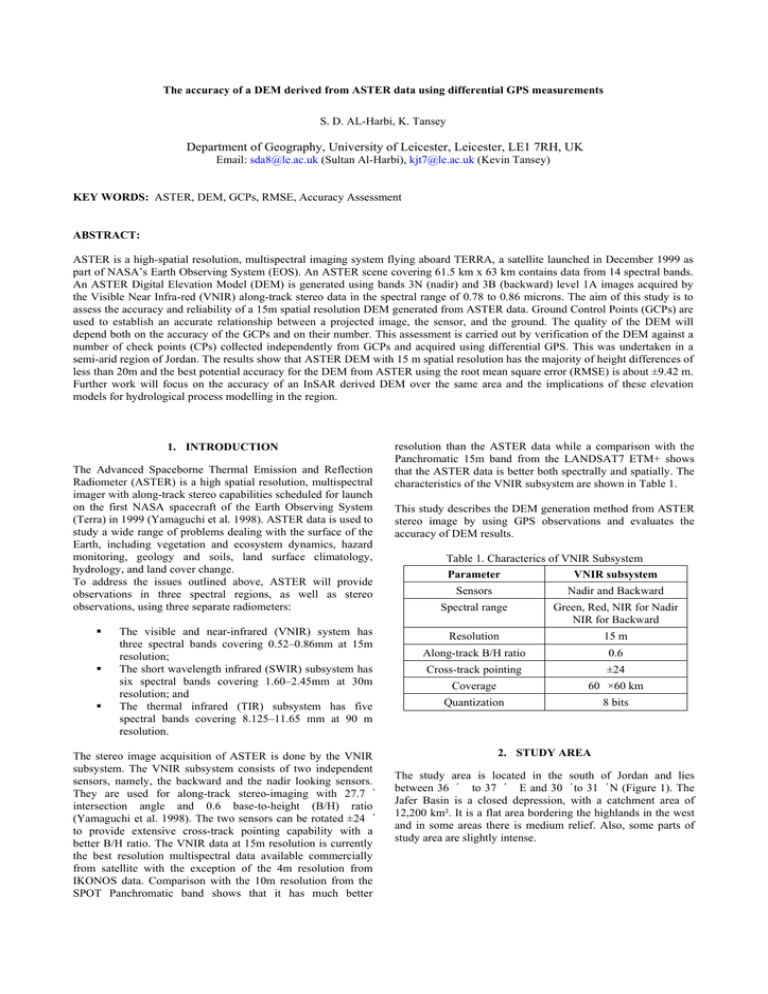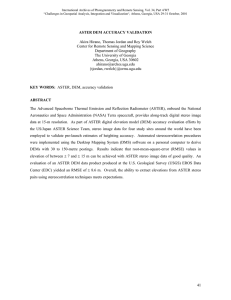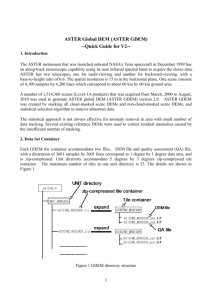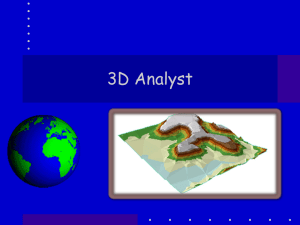Department of Geography, University of Leicester, Leicester, LE1 7RH, UK
advertisement

The accuracy of a DEM derived from ASTER data using differential GPS measurements S. D. AL-Harbi, K. Tansey Department of Geography, University of Leicester, Leicester, LE1 7RH, UK Email: sda8@le.ac.uk (Sultan Al-Harbi), kjt7@le.ac.uk (Kevin Tansey) KEY WORDS: ASTER, DEM, GCPs, RMSE, Accuracy Assessment ABSTRACT: ASTER is a high-spatial resolution, multispectral imaging system flying aboard TERRA, a satellite launched in December 1999 as part of NASA’s Earth Observing System (EOS). An ASTER scene covering 61.5 km x 63 km contains data from 14 spectral bands. An ASTER Digital Elevation Model (DEM) is generated using bands 3N (nadir) and 3B (backward) level 1A images acquired by the Visible Near Infra-red (VNIR) along-track stereo data in the spectral range of 0.78 to 0.86 microns. The aim of this study is to assess the accuracy and reliability of a 15m spatial resolution DEM generated from ASTER data. Ground Control Points (GCPs) are used to establish an accurate relationship between a projected image, the sensor, and the ground. The quality of the DEM will depend both on the accuracy of the GCPs and on their number. This assessment is carried out by verification of the DEM against a number of check points (CPs) collected independently from GCPs and acquired using differential GPS. This was undertaken in a semi-arid region of Jordan. The results show that ASTER DEM with 15 m spatial resolution has the majority of height differences of less than 20m and the best potential accuracy for the DEM from ASTER using the root mean square error (RMSE) is about ±9.42 m. Further work will focus on the accuracy of an InSAR derived DEM over the same area and the implications of these elevation models for hydrological process modelling in the region. 1. INTRODUCTION The Advanced Spaceborne Thermal Emission and Reflection Radiometer (ASTER) is a high spatial resolution, multispectral imager with along-track stereo capabilities scheduled for launch on the first NASA spacecraft of the Earth Observing System (Terra) in 1999 (Yamaguchi et al. 1998). ASTER data is used to study a wide range of problems dealing with the surface of the Earth, including vegetation and ecosystem dynamics, hazard monitoring, geology and soils, land surface climatology, hydrology, and land cover change. To address the issues outlined above, ASTER will provide observations in three spectral regions, as well as stereo observations, using three separate radiometers: The visible and near-infrared (VNIR) system has three spectral bands covering 0.52–0.86mm at 15m resolution; The short wavelength infrared (SWIR) subsystem has six spectral bands covering 1.60–2.45mm at 30m resolution; and The thermal infrared (TIR) subsystem has five spectral bands covering 8.125–11.65 mm at 90 m resolution. The stereo image acquisition of ASTER is done by the VNIR subsystem. The VNIR subsystem consists of two independent sensors, namely, the backward and the nadir looking sensors. They are used for along-track stereo-imaging with 27.7 ْ intersection angle and 0.6 base-to-height (B/H) ratio (Yamaguchi et al. 1998). The two sensors can be rotated ±24 ْ to provide extensive cross-track pointing capability with a better B/H ratio. The VNIR data at 15m resolution is currently the best resolution multispectral data available commercially from satellite with the exception of the 4m resolution from IKONOS data. Comparison with the 10m resolution from the SPOT Panchromatic band shows that it has much better resolution than the ASTER data while a comparison with the Panchromatic 15m band from the LANDSAT7 ETM+ shows that the ASTER data is better both spectrally and spatially. The characteristics of the VNIR subsystem are shown in Table 1. This study describes the DEM generation method from ASTER stereo image by using GPS observations and evaluates the accuracy of DEM results. Table 1. Characterics of VNIR Subsystem Parameter VNIR subsystem Sensors Nadir and Backward Spectral range Green, Red, NIR for Nadir NIR for Backward Resolution 15 m Along-track B/H ratio 0.6 Cross-track pointing ±24 Coverage 60 ×60 km Quantization 8 bits 2. STUDY AREA The study area is located in the south of Jordan and lies between 36 ْ to 37 ْ E and 30 ْ to 31 ْ N (Figure 1). The Jafer Basin is a closed depression, with a catchment area of 12,200 km². It is a flat area bordering the highlands in the west and in some areas there is medium relief. Also, some parts of study area are slightly intense. other pointing backwards, with an offset angle of 26 degrees. There is an approximately 55 second interval between the time the nadir sensor passes over a ground location and the aft sensor records the same location on the ground track of the satellite. Images generated from the nadir and after sensors yield a B/H ratio of 0.6, which is close to ideal for generating DEMs by automated techniques for a variety of terrain conditions. A major advantage of the along-track mode of data acquisition is that the images forming the stereopairs are acquired a few seconds apart under uniform environmental and lighting conditions, resulting in stereopairs of consistent quality that are well suited to DEM generation by automated stereocorrelation techniques (Colvocoresses, 1982; Fujisada, 1994). Jordan Jafer Area Two types of DEM products can be generated: (1) a relative DEM where the elevations are not referenced to a ground or map datum; and (2) an absolute DEM where the elevations are referenced to a map datum or to ground control points which are observed by using GPS. The process for generating DEMs starts with the construction of a stereo pair by registering two images of the same ground area recorded from different positions in space. In the stereo pair, any positional differences parallel to the direction of satellite travel (parallax differences) are attributed to displacements caused by relief. The second step will be defining ground control points (GCPs) for absolute DEM, and determining tie points, which are used to define the epipolar geometry and create epipolar images, finally, an epipolar image will be generated. A pair of epipolar images is generated in order to retain elevation parallax in only one direction. The ground elevations are determined by measuring parallax differences in the registered images. Figure 1: Study area showing the Jafer basin 3. METHODOLOGY The ASTER stereo images used in this study were acquired on 19 June 2001, over the region of Al-Jafer, Jordan. The image data were processed using ENVI 4.2™. This software supports reading of the data, ground-control-point (GCP) collection, geometric modelling, DEM generation and editing. A field survey was conducted in September 2006 for the purpose of GCp acquisition. Differential GPS measurements were provided by two Leica SR20 GPS receivers. Height points were collected to calibrate the DEM. Height points were also collected to independently verify the quality and accuracy of the DEM. In the following experiments, the sensitivity of the accuracy based on the use of 8, 9, 10, 11 and 12 control points was evaluated, 25 tie points (TPs) were collected automatically between the stereo-pair. GCPs are the instrumental component of establishing an accurate relationship between the images in a project, the sensor, and the ground. GCPs are identifiable features located on the Earth’s surface that have known ground coordinates in X, Y, and Z. Horizontal control specifies only the X, Y, while vertical control specifies only the Z. 4. DEM GENERATION Digital elevation models are important data sources for many applications that are related to topographic surface analysis. Satellites can be used to generate DEM for the map production and other applications through different ways. Among the optical sensors, across-track stereoscopy has been widely used, for example SPOT 1 to 4. The two images of a stereopair are acquired pointing the sensor to the same area, with different incidence angles, in different orbits. Figure 2: Flow chart of the study 5. DEM ACCURACY ASSESSMENT Accuracy is the most important factor to be considered in the production of DEM because, if the accuracy of a DEM does not meet the requirements, then the whole project needs to be repeated and thus the economy and efficiency will ultimately be affected (Zhilin et al., 2005). An ASTER DEM can be generated either with or without GCPs. An absolute DEM is created with GCPs that are supplied with an absolute horizontal and vertical accuracy of up to 7m with appropriate GCPs. Along-track stereoscopic image acquisition requires two sensors with different inclinations, acquisition images at the same time. SPOT-5, the most recent satellite of the SPOT programme carries (Goncalves and Oliveira, 2002). That is also the case of ASTER, which requires two sensors, both sensible in the range of 0.78-0.86 mm, one pointing in the nadir direction and the 2 However, a relative DEM can be generated without GCPs with horizontal and vertical accuracy of up to 10 m. DEM accuracies depend on the presence or absence of GCPs. Altmaier (2002) stated that the DEM accuracy depends mainly on sensor model, image deformations, resolution. Also, the availability of accurate GCPs will allow production of absolute DEMs with accuracies depending on the number, quality and distribution of the GCPs as can be seen in Table 2. S= 6. RESULTS AND ANALYSIS With five different sets of GCPs and associated tie points (TPs), five DEMs were created from a single ASTER image (Table 3). From the statistical results, it was founded that: DEMs require comparison of the original elevations (e.g., elevations read from topographic maps or observed by GPS) with the elevations in a DEM surface. Such a comparison results in height differences (or residuals) at the tested points. Conventional methods to analyse the pattern of deviation between two sets of elevation data are to yield statistical expressions of the accuracy, such as the root mean square error, standard deviation, and mean. The most widely used measure is the Root Mean Square Error (RMSE). It measures the dispersion of the frequency distribution of deviations between the original elevation data and the DEM data, mathematically expressed as: ∑ (ZDEM - ZRef)² n (1) Where: ZDEM is the ith elevation value measured on the DEM surface, ZRef is the corresponding original elevation and n is the number of elevation points checked. The best result related to RMSE calculation was 9.42 m DEM B, whereas the majority (89%) of the absolute difference elevation (residual) values were less than 20 m; 78% were less than 15 m; also 78% were less than 10 m and 56% were less than 5 m. Moreover, the maximum error was less than 20.14 m and the minimum error was 9.27. The differences elevations (residual values) are mostly less than 20 m and in DEM A and DEM B 75% less than 10 m. The mean absolute error is less than 28 m, meaning that the distribution error is not very big. The RMSE for DEM A and DEM B had given excellent result for less than one pixel resolution; therefore, DEM can be regarded as high accuracy. This results from generating these DEM with nine GCPs, which are located in a nearly flat area. Also, the RMSE of the DEM C is not too large, about 1.6 pixels. However, the RMSE for DEM D and DEM E are more than 30 m. This is the result of increasing the GCPs that are located in the hill top areas. High altitude areas have slopes and their image positions do not reflect true ground position and therefore, X-Y references taken for such points result in a large RMSE. Table 3: Error statistics for DEMs NO of ME RMSE SD GCPs A 8 3.05 ±11.63 11.99 B 9 3.49 ±9.42 9.28 C 10 -9.03 ±18.69 17.25 D 11 -14.31 ±32.70 30.88 E 12 2.41 ±32.20 33.54 ME: mean error, RMSE: Root mean square error, SD: Standard division DEM The main attraction of the RMSE lies in its easy computation and straightforward concept. However, this index is essentially a single global measure of deviations, thus incapable of accounting for spatial variation of errors over the interpolated surface (Wood, 1996). The RMSE is not necessarily a good description of the statistical distribution of the error. Therefore, other researchers have suggested the use of a more complete statistical description of errors by reporting the mean error (ME) and error standard deviation. ∑ (ZDEM - ZRef) ME = n (3) ME can be either negative or positive, and records systematic under or overestimation of the elevations in the DEM. S records the dispersion, as does the RMSE, but if ME is relatively large then S and RMSE may be very different (Fisher and Tate, 2006). Table 2: DEM accuracies as a function of GCPs (Lang and Welch, 1999) GCPs DEM Product No. of GCPs Accuracy Accuracy Name (Minimum) (RMSExyz) (RMSExyz ) Relative 0 N/A 10-30 m DEM Absolute 1 15-30 m 15-50 m DEM Absolute 4 5-15 m 7-30 DEM RMSE = ∑ [(ZDEM - ZRef) - ME]² n -1 7. CONCLUSION (2) The generation of digital elevation models from ASTER data is a very suitable method compared to other methods like digitizing topographic maps or ground surveys. The extraction of height information using ASTER is a procedure that is economical both in time and money from which many further 3 Hashimoto T., 2000, DEM generation from stereo AVNIR image. Advances in Space Research, 25, 931-936. applications can benefit. Collecting most of GCPs in the flat area or low altitude and far fewer in a high altitude area can create very good DEM. In addition, the number and distribution of GCPs and TPs play a very important role in the final accuracy of the DEM. Further work will focus on the accuracy of an InSAR derived DEM over the same area and the implications of these elevation models for hydrological process modelling in the region. Li, Z., 1988, On the measure of digital terrain model accuracy. Photogrammetric Record, 12: 72, 873–877. Lang, H. and Welch, R., 1999, Algorithm theoretical basis document for ASTER digital elevation models, version 3.0. Jet Propulsion Laboratory, Pasadena, CA, USA. Monckton, C.G., 1994, An Investigation into the spatial structure of error in digital elevation data. In Worboys MF (ed). Innovations in GIS: Selected papers from the First National Conference on GIS Research UK (Taylor and Francis: London, UK), 201–211. 8. ACKNOWLEDGMENT The authors are grateful to the Jordan Badia Research and Development Center especially Dr. Saad Alayaash for logistical and academic support during field work. Toutin, T. and Cheng, P., 2001, DEM generation with ASTER stereo data. Earth Observation Magazine, 9, 7–21. Toutin, T. and Cheng, P., 2002, Comparison of automated digital elevation model extraction results using along-track ASTER and across-track SPOT stereo images. SPIE Journal, Optical Engineering, 41, 2102–2106. 9. REFERENCES Altmaier, A., Kany, C., 2002, Digital surface model generation from corona satellite images, ISPRS Jornal of Photogrammetry & Remote Sensing 56, 221-235. Yamaguchi, Y., Kahle, A., Tsu, H., Kawakami, T. and Pniel, M., 1998, Overview of Advanced Spaceborne Thermal Emission and Reflection Radiometer (ASTER). IEEE Transactions on Geoscience and Remote Sensing, 36, pp. 1062– 1071. Fujisada, H., 1998, ASTER level-1 data processing algorithm. IEEE Transactions on Geoscience and Remote Sensing, 36, 1101–1112. Fisher, P.F., 1998, Improved modeling of elevation error with geostatistics. GeoInformatica 2: 3, 215–233. Toutin, T., 2001, Elevation modeling from satellite visible and infrared (VIR) data. International Journal of Remote Sensing, 22, 1097–1125. Fisher, P.F. and Tate, N., 2006, Causes and consequences of error in digital elevation error. Progress in Physical Geography 30: 4, 467–489. Toutin T., 2001, DEM generation from new VIR sensors: IKONOS, ASTER and Landsat-7. IEEE-IGARSS Proceedings, Sydney, Australia. Goncalves, J. A., and Oliveira, A. M., 2002, Accuracy analysis of DEMs from ASTER imagery. Accessed on 10/1/2007 Wood, J.D., 1996, The geomorphological characterisation of digital elevation models PhD Thesis, University of Leicester. http://www.isprs.org/istanbul2004/comm3/papers/26 1.pdf Zhilin, L., Qing, Z., and Christopher, G., 2005, Digital terrain modelling : principle and methodology. Hirano, A., Welch, R. and Lang, H., 2003, Mapping from ASTER stereo image data: DEM validation and accuracy assessment. ISPRS Journal of Photogrammetry and Remote Sensing, 57, pp. 356–370. 4 Figure 3: ASTER derived DEM 1





